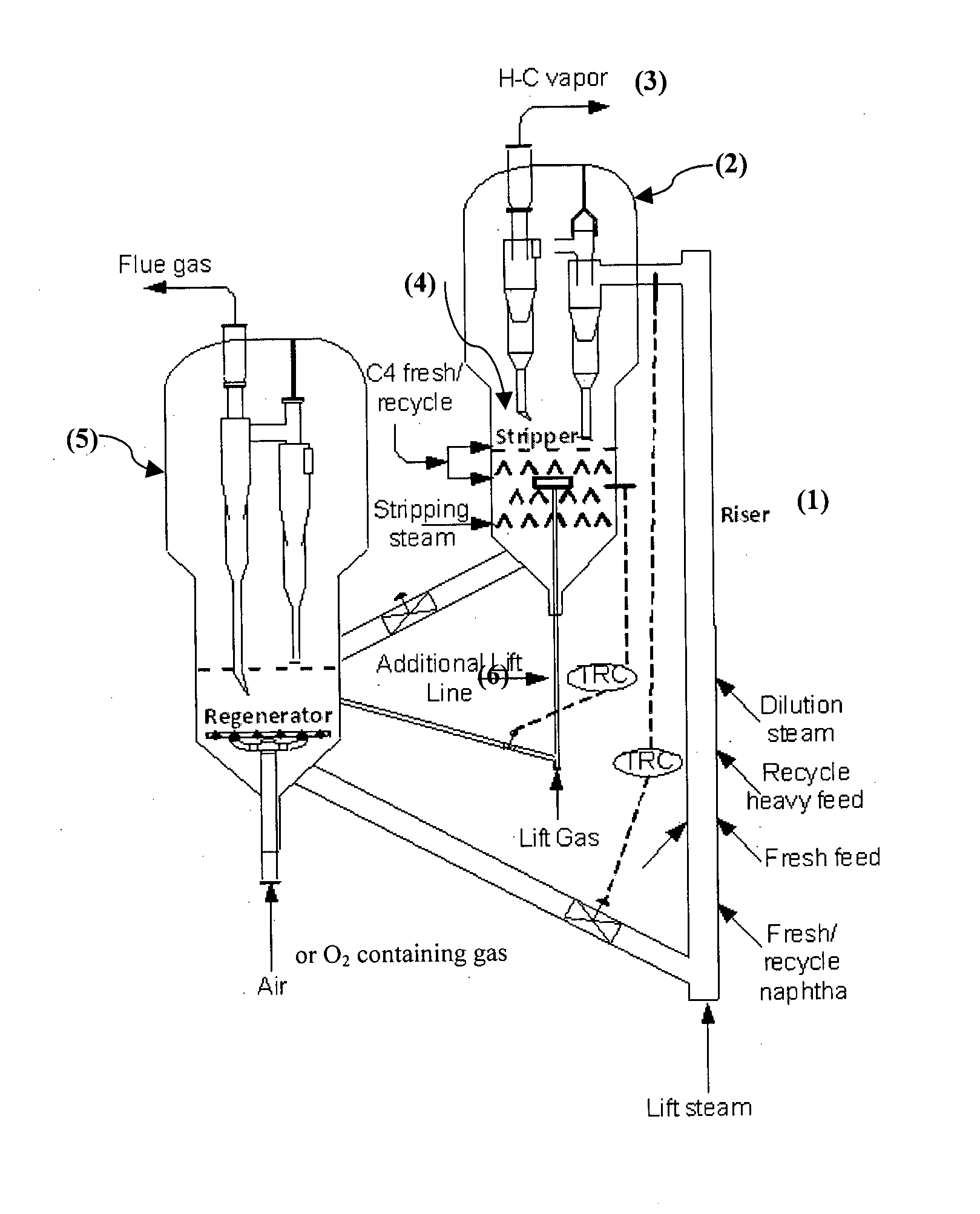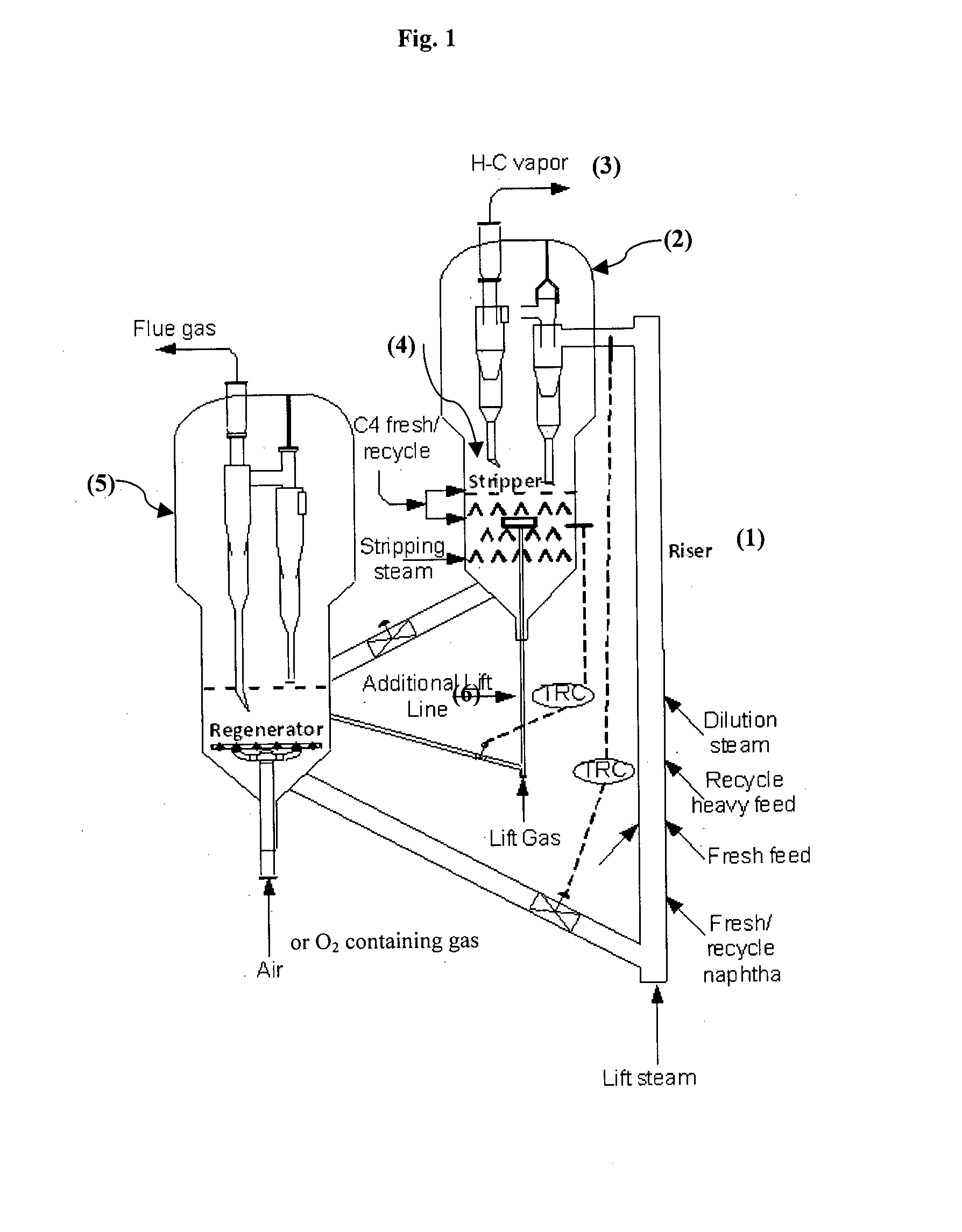PROCESS FOR PRODUCTION OF C3 OLEFIN IN A FLUID CATALYTIC CRACKING UNIT
a technology of fluid catalytic cracking and production process, which is applied in the direction of hydrocarbon oil treatment products, organic chemistry, chemistry apparatus and processes, etc., can solve the problems of not teaching the cracking method, the prior art does not teach the cracking of csub>4 /sub>hydrocarbons to csub>3 /sub>olefins, and the inability to meet the incremental demand of propylene, etc., to achieve high yield
- Summary
- Abstract
- Description
- Claims
- Application Information
AI Technical Summary
Benefits of technology
Problems solved by technology
Method used
Image
Examples
examples
[0032]The examples given in this section are for illustration purpose only and don't construe to the claims as mentioned in subsequent, section. The data are based on microreactor and pilot plant tests as well as preliminary engineering calculation. The study was carried out with a residue feed having 4.4 wt % conradson carbon residue (CCR) and 941 kg / m3 density. The catalyst used in this study is a mixture of FCC catalyst having average particle size of 80 microns based on USY zeolite and an additive based on pentasil zeolite having silica to alumina molar ratio of 30. The catalyst was hydrothermally deactivated at 810° C. for 5 hrs. The reaction temperature for catalytic cracking of the residue feed was maintained at 580° C. for all cases. Cracking the residue feed in reactor riser without any C4 cracking is considered as the ‘Base case’ for comparison purpose. Cracking of C4 stream both fresh and recycle is carried out in the stripper bed at optimum WHSV in the new cases.
example-i
[0033]This example demonstrates the improvement in propylene yield in FCCU obtained through cracking of the product C4 stream generated out of cracking of residue feed in the riser. The composition of C4 stream used in the study is given in Table-I. The improvement in propylene yield on fresh feed basis with recycle of C4 product into stripper without and with direct transfer of regenerated catalyst into stripper is presented in Table-II. Case I considers the recycle of C4 stream without any transfer of hot regenerated catalyst into the stripper and therefore ,reactions are conducted at a temperature close to riser outlet temperature. In Case-II, about 20 wt % of total catalyst flow from regenerator is directly transferred to the stripper which in turn increases the temperature to 600° C.
TABLE IComposition of C4 recycle streamComponentswt %i-butane23.6n-butane6.51-butene15i-butylene26.4cis-2-butene11.7trans-2-butene161,3-butadiene0.8
TABLE IIBasecaseCase-ICase-IIStripper zone temp° C...
example-ii
[0035]This example demonstrates the improvements in propylene yield in FCCU obtained through cracking of C4 stream from an external source. The composition of C4 stream used in the study is given in Table-III. Case-III and IV as given in Table-IV consider cracking of C4 feed without and with direct transfer of regenerated catalyst into stripper respectively. In Case-IV, about 20 wt % of total catalyst flow from regenerator is directly transferred to the stripper to raise the temperature to 600° C. The quantity of C4 stream was kept same as that of the earlier cases to maintain the same WHSV. Since the C4 stream is external and it is included in the fresh feed quantity, the percentage of C4 stream on fresh feed basis is coming lower than that of Example-I. Improvement in yields of propylene and ethylene in Case-IV over Case-III is 1.6 wt % and 0.7 wt % on fresh feed basis respectively.
TABLE IIIComposition of external C4 streamComponentswt %i-butane34.7n-butane0.91-butene2.0i-butylene...
PUM
| Property | Measurement | Unit |
|---|---|---|
| temperature | aaaaa | aaaaa |
| temperature | aaaaa | aaaaa |
| temperature | aaaaa | aaaaa |
Abstract
Description
Claims
Application Information
 Login to View More
Login to View More - R&D
- Intellectual Property
- Life Sciences
- Materials
- Tech Scout
- Unparalleled Data Quality
- Higher Quality Content
- 60% Fewer Hallucinations
Browse by: Latest US Patents, China's latest patents, Technical Efficacy Thesaurus, Application Domain, Technology Topic, Popular Technical Reports.
© 2025 PatSnap. All rights reserved.Legal|Privacy policy|Modern Slavery Act Transparency Statement|Sitemap|About US| Contact US: help@patsnap.com


